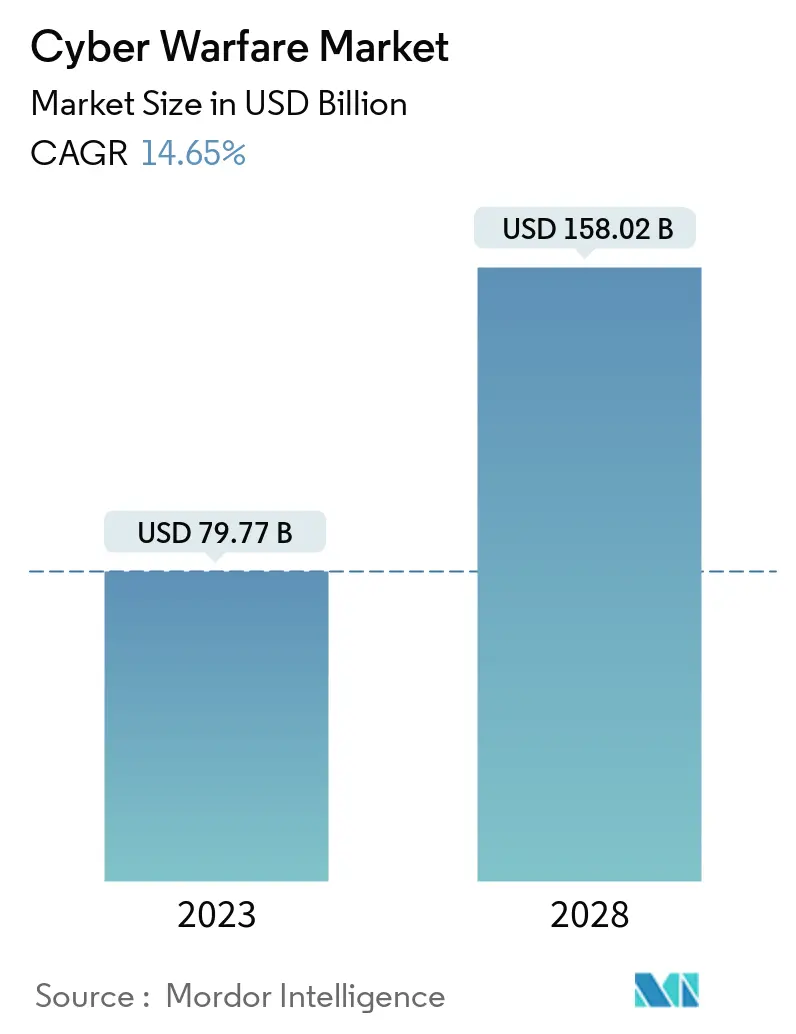Market Size of Cyber Warfare Industry

| Study Period | 2018 - 2028 |
| Market Size (2023) | USD 79.77 Billion |
| Market Size (2028) | USD 158.02 Billion |
| CAGR (2023 - 2028) | 14.65 % |
| Fastest Growing Market | Asia Pacific |
| Largest Market | North America |
Major Players
*Disclaimer: Major Players sorted in no particular order |
Need a report that reflects how COVID-19 has impacted this market and its growth?
Cyber Warfare Market Analysis
The Cyber Warfare Market size is expected to grow from USD 79.77 billion in 2023 to USD 158.02 billion by 2028, at a CAGR of 14.65% during the forecast period (2023-2028).
Cyberwarfare involves offensive and defensive operations, such as cyberattacks, espionage, and sabotage. The number of cyberattacks worldwide is increasing significantly. Cyberwarfare uses all vectors accessible to cybercriminals. These include viruses, email attachments, pop-up windows, instant messages, and other forms of deception on the internet.
- Cyberwarfare is a significant threat to the nation, outstripping terrorism. The mitigation of losses arising due to increasing cyber-attacks on countries, leading to economic disruption, has become a considerable concern for the market.
- Based on such threats, governments of the United States, India, Japan, and Pakistan are readily preparing for cyber espionage and taking steps toward establishing a strong national cyber policy to protect their civilian and military infrastructure.
- For instance, in June 2021, with the threat of cyberattacks mounting against the Indian armed forces, the Department of Military Affairs (DMA) has planned to send up to 100 personnel to the United States to train in the latest cybersecurity technology and artificial intelligence (AI) for future warfare.
- An increase in defense spending to improve the government's effectiveness, efficiency, and cybersecurity capability is expected to be a driving factor in deploying cyber warfare systems across all geographic regions. Modernizing government IT infrastructure, improving deteriorated facilities, and reducing cyber vulnerabilities are also expected to drive the market during the forecast period.
- DoS attacks, which continue to increase worldwide, are predicted to be leveraged for conducting cyber warfare. Attackers are also using these distributed denials of service (DDoS) attack methods to impact government entities, primarily with massive, sustained bandwidth attacks and, at the same time, infecting them with malware and spyware to steal or destroy data.
- Moreover, according to Microsoft's Digital Defense Report (2021), around 80% of nation-state-targeted attacks were on governments, NGOs, and think tanks. Think tanks generally serve as policy incubators and implementers, with strong ties to government officials and programs. Attackers can exploit the connections between the NGO community and government organizations to gain insights into national policy plans and intentions.
- The key players in the market are coming up with new solutions to remain competitive and increase their capability. In September 2021, BAE Systems Applied Intelligence expanded its NetReveal Compliance Solution Suite with market-leading enhancements to assist organizations in remaining compliant in the complex and evolving money laundering and terrorist finance ecosystem. The NetReveal AML Transaction Monitoring solution now includes a detection library of modern typologies and payment types, such as human trafficking and mobile payments.
- Because of COVID-19, Nation-state cyber activity has witnessed a surge in intensity and an escalation in severity because traditional tactics to gather intelligence and knowledge are no longer feasible due to social distancing. Additionally, cyberattacks targeting organizations have increased considerably amid the coronavirus-led lockdown, resulting in a growing demand for skilled cybersecurity professionals.
